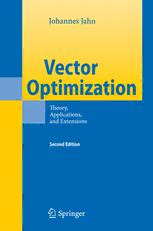Table Of ContentVector Optimization
Johannes Jahn
Vector Optimization
Theory, Applications, and Extensions
Second Edition
Prof. Dr. Johannes Jahn
Universität Erlangen-Nürnberg
Department Mathematik
Martensstraße 3
91058 Erlangen
Germany
[email protected]
ISBN 978-3-642-17004-1 e-ISBN 978-3-642-17005-8
DOI 10.1007/978-3-642-17005-8
Springer Heidelberg Dordrecht London New York
Springer-Verlag Berlin Heidelberg 2011
This work is subject to copyright. All rights are reserved, whether the whole or part of the material is
concerned, specifically the rights of translation, reprinting, reuse of illustrations, recitation, broadcasting,
reproduction on microfilm or in any other way, and storage in data banks. Duplication of this publication or
parts thereof is permitted only under the provisions of the German Copyright Law of September 9,
1965, in its current version, and permission for use must always be obtained from Springer. Violations
are liable to prosecution under the German Copyright Law.
The use of general descriptive names, registered names, trademarks, etc. in this publication does not imply,
even in the absence of a specific statement, that such names are exempt from the relevant protective
laws and regulations and therefore free for general use.
Cover design: WMXDesign GmbH
Printed on acid-free paper
Springer is part of Springer Science+Business Media (www.springer.com)
To Claudia and Martin
Preface
In vector optimization one investigates optimal elements such as min-
imal, stronglyminimal, properlyminimalorweaklyminimalelements
of a nonempty subset of a partially ordered linear space. The prob-
lem of determining at least one of these optimal elements, if they
exist at all, is also called a vector optimization problem. Problems of
this type can be found not only in mathematics but also in engineer-
ing and economics. Vector optimization problems arise, for example,
in functional analysis (the Hahn-Banach theorem, the Bishop-Phelps
lemma,Ekeland’svariationalprinciple),multiobjectiveprogramming,
multi-criteria decision making, statistics (Bayes solutions, theory of
tests, minimal covariance matrices), approximation theory (location
theory,simultaneousapproximation,solutionofboundaryvalueprob-
lems) and cooperative game theory (cooperative n player differential
games and, as a special case, optimal control problems). In the last
two decades vector optimization has been extended to problems with
set-valued maps. This new field of research, called set optimization,
seems to have important applications to variational inequalities and
optimization problems with multivalued data.
TherootsofvectoroptimizationgobacktoF.Y.Edgeworth(1881)
and V. Pareto (1906) who have already given the definition of the
standard optimality concept in multiobjective optimization. But in
mathematics this branch of optimization has started with the leg-
endary paper of H.W. Kuhn and A.W. Tucker (1951). Since about
vii
viii Preface
the end of the 1960’s research is intensively made in vector optimiza-
tion.
It is the aim of this book to present various basic and important
results of vector optimization in a general mathematical setting and
to demonstrate its usefulness in mathematics and engineering. An
extension to set optimization is also given. The first three parts are a
revised edition of the former book [160] of the author. The forth part
on engineering applications and the fifth part entitled extensions to
set optimization have been added.
The theoretical vector optimization results are contained in the
second part of this book. For a better understanding of the proofs
several theorems of convex analysis are recalled in the first part. This
part concisely summarizes the necessary background material and
may be viewed as an appendix.
Themainpartofthisbookbeginsonpage102withadiscussionof
several optimality notions together with some simple relations. Nec-
essary and sufficient conditions for optimal elements are obtained by
scalarization, i.e. the original vector optimization problem is replaced
by an optimization problem with a real-valued objective map. The
scalarizing functionals being used are certain linear functionals and
norms. Existence theorems for optimal elements are proved using
Zorn’s lemma and the scalarization theory. For vector optimization
problems with inequality and equality constraints a generalized La-
grange multiplier rule is given. Moreover, a duality theory is devel-
oped for convex maps. These results are also specialized to abstract
linear optimization problems. The third part of this book is devoted
to the application of the preceding general theory. For vector ap-
proximationproblemstheconnectionstosimultaneousapproximation
problems are shown and a generalized Kolmogorov condition is for-
mulated. Furthermore, nonlinear and linear Chebyshev problems are
considered in detail. The last section is entitled cooperative n player
differentialgames. Theseincludeoptimalcontrolproblems. Forthese
games a maximum principle is proved.
In the part on engineering applications the developed theoretical
results are applied to multiobjective optimization problems arising in
engineering. After a presentation of the theoretical basics of multiob-
jective optimization numerical methods are discussed. Some of these
Preface ix
methods are applied to concrete nonlinear multiobjective optimiza-
tion problems from electrical engineering, computer science, chemical
engineering and medical engineering. The last part extends the sec-
ond part of this book to set optimization. After an introduction to
thisfieldofresearchincludingbasicconceptsthenotionofthecontin-
gent epiderivative is discussed in detail. Subdifferentials are the topic
together with a comprehensive chapter on optimality conditions in
set optimization.
This book should be readable for students in mathematics whose
background includes a basic knowledge in optimization and linear
functional analysis. Mathematically oriented engineers may be inter-
ested in the forth part on engineering applications.
The bibliography contains only a selection of references. A reader
whoisinterestedinthefirstpapersofvectoroptimizationisrequested
to consult the extensive older bibliographies of Achilles-Elster-Nehse
[1], Nehse [258] and Stadler [312].
This second edition is a revised version containing two new sec-
tions,additionalremarksonthecontributionofEdgeworthandPareto
and an updated bibliography.
I am very grateful to Professors W. Krabs, R.H. Martin and B.
Brosowskifortheirsupportandvaluablesuggestions. IalsothankDr.
D.Diehl, Dr.G.Eichfelder andDr. E.Schneiderfor usefulcomments.
Moreover, I am indebted to A. Garhammer, S. Gmeiner, Dr. J. Klose,
Dr. A. Merkel, Dr. B. Pfeiffer and H. Winkler for their assistance.
Erlangen, September 2010 Johannes Jahn

